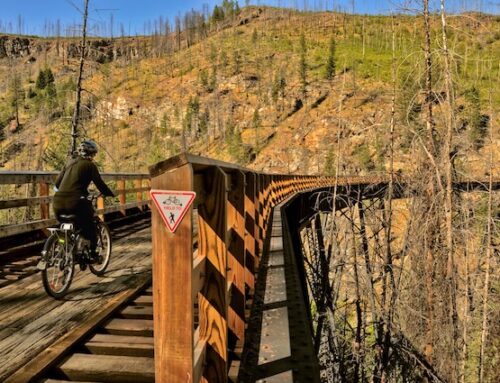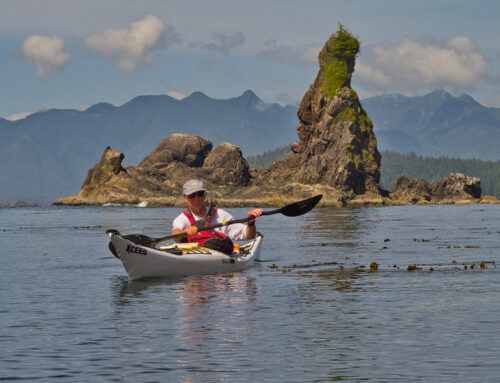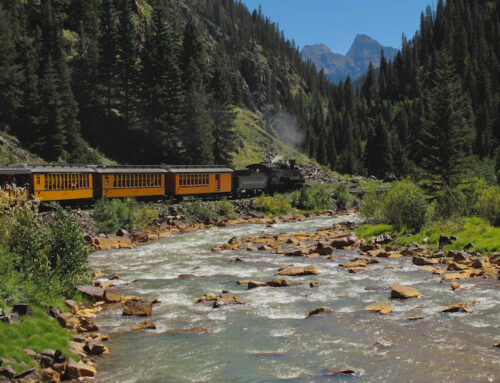Anchorage to the Portage Valley, Exploring by Car, Foot and Kayak
About 1 hour south of Anchorage you can easily see glaciers from the road along the Portage Valley. The drive there takes you right along the edge of Turnagain Arm and the surrounding mountains are truly spectacular. Turnagain Arm is also interesting in that it is very shallow and practically dries out at low tides. In fact, it has the 2nd highest tides in the world next to the Bay of Fundy. Like the Bay of Fundy, it also has a tidal bore that runs in twice a day.
The Portage Valley runs east to west from Turnagain Arm up to the mountains blocking the passage to Whittier. It is a spectacular valley surrounded by mountains covered in ice fields and glaciers and is well worth taking the time to explore. There is good hiking and biking opportunities, paddling on the relatively gentle Portage River and a couple of easily accessible lakes, and there are two of good sized state campgrounds as well as one privately run RV Park.
At the end of the valley, just before you enter the tunnel, which takes you 2 ½ miles through the mountain to Whittier, you come upon Portage Lake. Portage is a glacial lake formed in a depression left by receding glaciers. 100 years ago it didn’t even exist, as the glaciers extended right to the end of the present day lake.
At the northern end of the lake is the Begich, Boggs Visitor Centre, part of Chugach National Forest, which is not only an impressive structure in itself, but has lots of interesting displays of the history and natural history of the area. From the visitor center you can hike or bike the paved and board-walked Trail of Blue Ice, which runs the entire length of the Portage Valley following along the base of the mountains and Williwaw creek. From the trail you can look up at 2 different glaciers. There is also another short trail, just up the road from the center, leading right up to the base of Byron Glacier.
Portage Lake is worth exploring. Portage Glacier stills calves off into the water at the far end of the lake and because it comes in at an angle behind a point of land, it can only be seen from the water. There are two ways to get up there to have a look; you can take the tour boat, MV Ptarmigan. Tickets are available at the interpretive center, and it is a one-hour ride that will take you right up to the base of the glacier. They hang around up there for a while so you can get a good look and hopefully get to see the glacier calve. For more information on the boat tour check out our review: Portage Lake Glacier Cruise. The only other way to see the glacier is to paddle there by canoe, kayak or standup paddle board. There are no hiking trails around the lake due to the very steep cliff faces and there are no boat ramps for larger boats. If you do choose to paddle, the park staff ask you to launch at a site on the northeast corner of the lake. There is a pull off and parking area just past the first tunnel before you get to the Whittier tunnel. From here there is a short path down to the lake where you can launch your craft. It is about a 2.5 mile paddle up the lake. Because of the hazard posed by falling ice they also don’t want paddlers getting too close, not just because of the risk of being hit by falling ice, but inexperienced paddlers can get knocked over by the large waves that are generated by the ice falls.
The paddle down the lake gives you stunning views of the surrounding mountains and snowfields, and there are dozens of waterfalls cascading 100’s of feet down the sides of the near vertical slopes into the lake.
I started my paddle fairly early in the morning to avoid the possibility of crowds, which are more prevalent on weekends at this time of year, and to stay ahead of the tour boat, which Linda was going to take. That allowed me to paddle a little closer, still at a safe distance mind you, to the glacier face. I was able to get lots of great photo ops and paddle among some small berglets before heading to a beach for a break. Unfortunately, while I was on the beach a part of the glacier I couldn’t see decided to calve. There was a huge thundering crack and a large amount of spray came flying out from behind the rocks followed by a large swell of water. On the beach, a ½ mile away, it was as if a large boat had gone by, setting up a series of large waves crashing on the beach. Shortly after a large raft of ice flowed out from the glacier into the lake.
Paddlers also need to be aware that conditions on the lake can change rapidly, as strong winds can get funneled up the valley. You also need to be aware of the hazards of paddling in icy cold water and dress accordingly. You should also know how to reenter your craft should you find yourself in the water, and you should always where a Personal Floatation device. Invariably, someone perishes in these lakes each year.
Portage Lake is a spectacular paddle and an easy opportunity to get a closer look at a glacier and paddle around some ice.
For more photos of the Portage Valley, Portage Lake and the Portage Glacier or if you would like to purchase images for download or prints, click this link: Photos of Portage Valley

























Leave A Comment